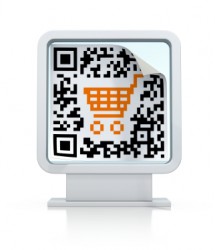 Consumers are increasingly reviewing product information online before the sale to help guide their buying decisions. QR codes are a great vehicle to provide product information to buyers throughout the pre-purchase research process. If you use them effectively, QR codes can also help your brand stay on the short list throughout the customer’s buying decision and help promote the sale. 18% of customers have scanned QR codes to make a purchase according to Chadwick Martin Bailey, so it’s important to use QR codes to help guide the customer’s buying decision. Below we share examples to help maximize your use of QR codes in pre-purchase research.
Consumers are increasingly reviewing product information online before the sale to help guide their buying decisions. QR codes are a great vehicle to provide product information to buyers throughout the pre-purchase research process. If you use them effectively, QR codes can also help your brand stay on the short list throughout the customer’s buying decision and help promote the sale. 18% of customers have scanned QR codes to make a purchase according to Chadwick Martin Bailey, so it’s important to use QR codes to help guide the customer’s buying decision. Below we share examples to help maximize your use of QR codes in pre-purchase research.
QR Codes on Websites: Yes, we do!
QR codes on websites work especially well for products that a customer may want to review, see, test, or try on before buying, such as building products, home goods for interior decorating, automotive products or clothing. It might seem counter intuitive, but QR codes on websites actually enable the sale by making it more convenient for customers to purchase or review your product at a later time. QR codes can simplify the process of transferring information from a website to a prospect’s smartphone. For example, Mary’s Bridal includes a unique QR code on their bridal dress webpages. Customers can then review links in their QR Reader’s scanning history in stores to select which dresses they would like to try on. Mary’s Bridal could improve their use of QR codes if the QR scan took users directly to a mobile webpage optimized for viewing on smartphones. Library Thing’s mobile platform, Library Anywhere, accomplishes just that. The platform automatically generates a QR code for each webpage in a library’s digital catalog. Scanning the QR code takes users to a mobile catalog on any web-enabled smartphone where saved items can be quickly retrieved for later viewing or checkout. Manufacturers can apply these examples by providing QR codes on their websites that customers can scan to approach distributors with the exact product model and specifications.
QR Code Catalog: Oh, the convenience!
Many printed catalogs, brochures and flyers miss the opportunity to prompt the digital engagement and interaction with your brand that is afforded by Quick Response Codes. Just as in the Library Thing example above, QR codes used in printed materials can link to a mobile webpage where users can review and save items for later viewing, which helps to keep your brand top of mind in the purchase decision and transfers data about your company’s products directly to the prospect’s smartphone for later viewing – perhaps even in a storefront. Per our previous blog, How to Effectively Market Your Brand in a Catalog, a great way to promote the sale with QR codes is to actually remind prospects to visit your store in person. A brief message such as, “Save a color swatch and bring it into the store today!” can be an effective call to action for the in-person follow up needed to close the sale. If you want to automate the shopping process even further, assign a unique QR code to each item in your catalog and enable your customers to purchase products directly from their smartphones with QR codes linking to a mobile-optimized e-commerce website. A great example of providing convenience with the scan is Tesco’s QR-driven shopping experience in South Korea.
QR Codes in your Storefront: Embrace the shift
QR codes are increasingly being used in show rooms and storefronts to provide consumers with product reviews and competitive information to help with their buying decisions. Best Buy is a leader in QR adoption that has embraced this new model. At Best Buy, customers can scan QR codes in stores to compare the scanned item with coordinating products, narrow product selection by prioritizing features and to ultimately select the product best suited to their needs. There is obviously a risk that consumers may use the information provided through a QR scan to shop with a competitor, but with consumers increasingly reviewing online information to narrow their buying decisions, this may be a risk worth taking. By being transparent with product information, you make the buying decision easier for the consumer while also increasing your chances of staying on the short list throughout the buying decision.
Conclusion
From website to smartphone to store, brochure to smartphone to store, or showroom to website to purchase, QR codes are being used in many forward thinking ways to simplify pre-purchase research and to promote the sale. With consumers increasingly looking to online channels for information during the pre-purchase process, it’s more important than ever to make it easier and more convenient for your customers to research your products before the sale.
Above we’ve provided some innovative uses of QR codes in the pre-purchase research process. What QR pre-purchase model (website to smartphone or store, brochure to smartphone to store, or showroom to website to purchase) applies best to your business model?
Tags: QR Codes, Distributed Sales Model, Building Products, QR Code Strategy




